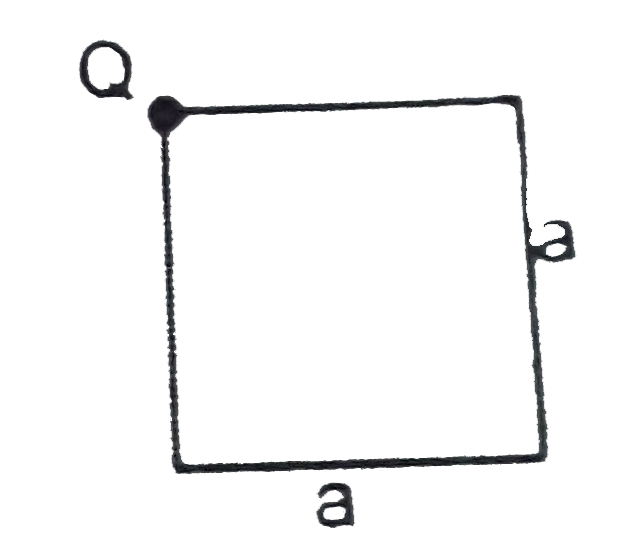A point charge Q is kept at the centre of a square face of edge length a. Calculate the amount of flux linked with the square face due to electric field of given point charge.
To solve the problem of calculating the electric flux linked with a square face due to a point charge Q placed at its center, we can follow these steps:
Step 1: Understand Electric Flux
Electric flux (Φ) through a surface is defined as the product of the electric field (E) and the area (A) of the surface, taking into account the angle (θ) between the electric field lines and the normal (perpendicular) to the surface:
Φ=E⋅A⋅cos(θ)
Step 2: Identify the Configuration
In this case, we have a point charge Q located at the center of a square face. The edge length of the square face is given as 'a'. The square face is perpendicular to the electric field lines emanating from the charge.
Step 3: Determine the Electric Field Due to the Point Charge
The electric field (E) due to a point charge Q at a distance r from the charge is given by:
E=kQr2
where k is Coulomb's constant (k≈8.99×109N m2/C2).
Step 4: Calculate the Distance from Charge to the Square Face
The distance from the point charge at the center of the square face to any point on the square face is a2 (half the length of the edge of the square).
Step 5: Calculate the Electric Field at the Square Face
Substituting r=a2 into the electric field formula:
E=kQ(a2)2=4kQa2
Step 6: Calculate the Area of the Square Face
The area (A) of the square face is given by:
A=a2
Step 7: Determine the Angle θ
Since the electric field lines from the point charge are perpendicular to the square face, the angle θ=0. Therefore, cos(0)=1.
Step 8: Calculate the Electric Flux
Now we can substitute the values into the electric flux formula:
Φ=E⋅A⋅cos(θ)=(4kQa2)⋅(a2)⋅1
This simplifies to:
Φ=4kQ
Final Answer
The amount of electric flux linked with the square face due to the electric field of the point charge Q is:
Φ=4kQ
---
Electric flux (Φ) through a surface is defined as the product of the electric field (E) and the area (A) of the surface, taking into account the angle (θ) between the electric field lines and the normal (perpendicular) to the surface:
Φ=E⋅A⋅cos(θ)
In this case, we have a point charge Q located at the center of a square face. The edge length of the square face is given as 'a'. The square face is perpendicular to the electric field lines emanating from the charge.
The electric field (E) due to a point charge Q at a distance r from the charge is given by:
E=kQr2
where k is Coulomb's constant (k≈8.99×109N m2/C2).
The distance from the point charge at the center of the square face to any point on the square face is a2 (half the length of the edge of the square).
Substituting r=a2 into the electric field formula:
E=kQ(a2)2=4kQa2
The area (A) of the square face is given by:
A=a2
Since the electric field lines from the point charge are perpendicular to the square face, the angle θ=0. Therefore, cos(0)=1.
Now we can substitute the values into the electric flux formula:
Φ=E⋅A⋅cos(θ)=(4kQa2)⋅(a2)⋅1
This simplifies to:
Φ=4kQ
The amount of electric flux linked with the square face due to the electric field of the point charge Q is:
Φ=4kQ
Topper's Solved these Questions
- ELECTRIC CHARGES AND FIELDS BOOK - MODERN PUBLICATIONCHAPTER - ELECTRIC CHARGES AND FIELDS EXERCISE - Conceptual Questions
51 Videos
- ELECTRIC CHARGES AND FIELDS BOOK - MODERN PUBLICATIONCHAPTER - ELECTRIC CHARGES AND FIELDS EXERCISE - Tough & Tricky Problems
20 Videos
- ELECTRIC CHARGES AND FIELDS BOOK - MODERN PUBLICATIONCHAPTER - ELECTRIC CHARGES AND FIELDS EXERCISE - Chapter Practice Test
15 Videos
- DUAL NATURE OF RADIATION AND MATTER BOOK - MODERN PUBLICATIONCHAPTER - DUAL NATURE OF RADIATION AND MATTER EXERCISE - CHAPTER PRACTICE TEST
15 Videos
- ELECTROMAGNETIC INDUCTIONBOOK - MODERN PUBLICATIONCHAPTER - ELECTROMAGNETIC INDUCTIONEXERCISE - CHAPTER PRACTICE TEST FOR BOARD EXAMINATION
14 Videos
Similar Questions
Knowledge Check
A point charge Q is kept at the centre of a square face of edge length a. The amount of electric flux associated with the square face in
AQ6ε0BQ24ε0CQ8ε0D0A charge q is located at centre of a cube of edge length 'a' The electric flux through any force
Aq∈0Bq6∈0Cq6a2∈0D4π∈0q6a2a point charge q is placed at the centre of a cylinder of length L and radius R the electric flux through the curved surface of the cylinder is
Aqε0L√L2+R2Bqε0L√L2+2R2Cqε0L√L2+4R2Dq2ε0
A point charge Q is placed at the corner of a square of side a. Find the flux through the square.
View SolutionA point charge Q is placed at the corner of a square of side a, then find the flux through the square.

View SolutionA point charge q is placed at the centre of a cube of side length a .The electric flux emerging from one of the face of cube is
View SolutionFour point charges are placed at the corners of a square of side l. Calculate potential at the centre of square.

View SolutionA charge Q is placed at the corner of a cube of edge length L. The electric flux linked to one of the faces not touching the charge Q is
View Solution
